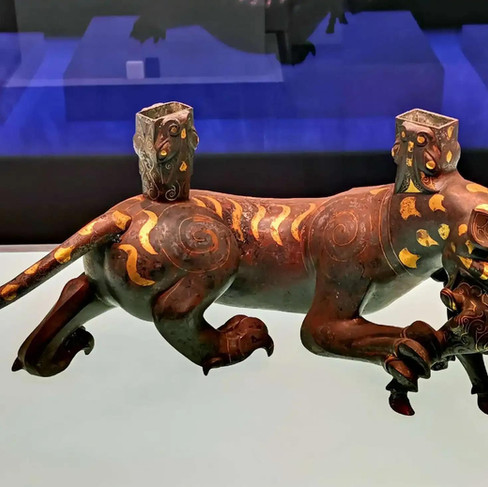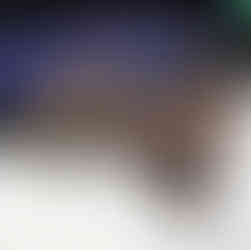青銅筆記 Vol.14 中山王墓:錯金銀虎噬鹿銅屏風座 - Warring State Bronze Screen Holder Featuring A Tiger Devouring A Deer from the Tomb of Zhongshan Wang
- SACA

- Nov 5, 2024
- 6 min read

1977年平山縣三汲村戰國中山王厝墓出土。 長51釐米。猛虎身軀渾圓、色彩斑斕,弓身右曲,三足著地,一爪騰起,正將捕捉的小鹿送入張開的巨口之中。老虎的凶猛與小鹿的羸弱形成鮮明對比。典型的戰國時代風格。動物腹下刻有銘文,說明製作時間及官匠姓名。
1974年河北省文物部門接到報告,平山縣三汲鄉農民大規模平整農田,不斷到附近兩座大土丘上取土,一些古代文物已被挖出並造成了破壞, 考古人員迅速趕到現場,對現場進行清理勘察。中字形的墓室格局證明這是一個王的陵墓,考古工作者發現這個墓穴的主墓室已經遭到了嚴重的盜掘。正當失落的情緒在發掘現場滋生的時候,一件非常意外的事情發生了。民工在取土時,一腳踩出了個大窟窿。對窟窿進行清理後,發現原來是個庫。庫與主墓室毫不相連,這種墓葬形式,以後被證明為是戰國時期中山國陵墓所獨有的,也正是由於庫的存在,才使大量的珍貴文物躲過盜劫,得以為世人所見。
隨著1號墓兩側庫的打開,人們如願以償的發現了數量眾多的珍貴文物,最先出土的是大量奇巧瑰麗的生活用品。錯金銀虎噬鹿銅屏風座、錯金銀雙翼神獸、戰國錯金銀四龍四鳳銅方案、十五連盞銅燈等相繼出土。出土器物的精美顯然大大超出了人們印象中,考古學家清理到西庫的時候,一件高63釐米、重28公斤的巨大青銅方壺上,四面刻滿了450個字的銘文。它告訴後人,這裡埋葬著中山國歷史上最偉大的一位君王, 他的名字叫“錯”。文中提到“皇祖文武、桓祖成考”,說明在“錯”之前, 還有文公、武公、桓公、成公四位先王。據推斷,1號墓中的“錯”是中山國的第五代君王。方壺的出土,彌補了史書中對中山王世系缺失記載的遺憾,具有極其重要的歷史研究價值。
錯金銀虎噬鹿銅屏風座長51釐米、高21.9釐米、重26.6公斤。器座以虎為主體,虎雙目圓睜,兩耳直竪,正在吞食一隻柔弱的小鹿。小鹿在虎口中拼命掙扎,短尾用力上翹,始終無法脫身。虎後肢用力蹬地,前軀下踞,整個身軀呈弧形,虎的右前爪因抓鹿而懸空,座身平衡借用鹿腿支撐。整個器形構思巧妙而自然。虎、鹿皮毛斑紋均用金銀鑲錯而成,生動逼真。
虎的項部和臀部各立一個長方形銎。銎兩側同飾山羊頭面,羊口即為銎口。沿兩銎口直線相交,可成84度交角,接近直角,安上屏扇恰成曲尺形。整件器物表現出虎、鹿的動態和身軀結構,增加了器物的藝術效果。此物器物構思巧妙,鑄工精湛,在國內十分罕見。
虎腹下铸有竖读铭文:“十四祀,牀麀,啬夫徐戠,制省器”12字 ,记述了器物铸造者、墓主人墓葬的级别和浩大的墓葬场面。
古時候,由於許多宮殿前部敞開,房屋建築也不太嚴密,需在房內張設屏風擋風,同時一所建築往往具有多種功能,需要隨時用屏風分割室內空間,因此,屏風的使用非常廣泛。這一風俗不難考證,許多古代墓葬中都有使用屏風的壁畫、畫像磚,也有出土小型模型和實用的屏風。
中山王“錯”墓的屏風座據考證是發現年代最早的一件實物,由屏風扇和屏風座兩部分組成。漆木制的扇面已經腐朽,但仍可以看出原物的形狀、顏色和尺寸。屏風原為兩扇圍屏,呈矩尺形。扇面塗紅漆,邊框塗黑漆,漆上用紅色和橙色繪畫出活潑的小鳥和翻騰的雲氣。每扇屏風的立框中間,都鑲有一個銅質獸面鋪首銜環作為裝飾。屏風底座是三件銅質錯金銀動物。

In 1974, the Hebei Provincial Cultural Relics Department received a report that farmers in Sanji Township, Pingshan County, were extensively leveling farmland, frequently taking soil from two nearby mounds, and ancient artifacts had been unearthed and damaged. Archaeologists quickly arrived at the site and began clearing and surveying. The T-shaped tomb structure indicated this was a royal tomb, although the main chamber had suffered severe looting. However, amidst the initial disappointment at the site, an unexpected discovery occurred. While digging for soil, a worker stepped into a large cavity. Upon clearing it, they found it was a separate storage chamber, not connected to the main burial chamber. This type of burial structure would later be identified as unique to the tombs of the Zhongshan State from the Warring States period. Thanks to this separate chamber, a large number of precious artifacts were preserved from theft and remained accessible for modern discovery.
As the storerooms on either side of Tomb No. 1 were opened, numerous valuable artifacts were uncovered, including intricate and beautiful daily-use items. Among these were a gold and silver inlaid bronze screen holder featuring a tiger devouring a deer, a gold and silver inlaid double-winged mythical beast, a four-dragon, four-phoenix bronze table with gold and silver inlay, and a fifteen-cup bronze lamp. The exquisite craftsmanship of these items exceeded prior expectations. When archaeologists reached the western storeroom, they found a massive 63-centimeter-tall, 28-kilogram bronze square vessel, engraved with 450 characters on all four sides. The inscription revealed that this tomb held the remains of the greatest king in the history of Zhongshan State, a ruler named Cuo. The inscription also mentioned "Emperor Wenwu" and "Ancestor Cheng," indicating that four previous kings—Duke Wen, Duke Wu, Duke Huan, and Duke Cheng—had ruled before Cuo. Thus, it is inferred that Cuo was the fifth ruler of Zhongshan State. The discovery of this vessel provided crucial information to fill historical gaps in the genealogy of the Zhongshan kings and held immense historical value.
The bronze screen holder featuring a tiger devouring a deer measures 51 cm in length, 21.9 cm in height, and weighs 26.6 kg. The base of the artifact features a tiger as the main figure, with wide eyes, erect ears, and a posture showing it devouring a helpless young deer. The deer struggles in the tiger's jaws, its short tail raised in an attempt to escape but to no avail. The tiger’s hind legs press against the ground, its body forming an arc as it crouches forward, while its right forepaw is lifted, gripping the deer, with the base balanced on the deer’s legs. The design is intricate yet natural, with both the tiger’s and deer’s fur patterns inlaid in gold and silver, creating a vivid and realistic appearance.
Two rectangular sockets are positioned on the tiger’s neck and hindquarters, each adorned with a goat head on either side, with the goat’s mouth forming the socket’s opening. When aligned, these sockets form an 84-degree angle, close to a right angle, making it possible to attach screen panels in an L-shape. The piece vividly portrays the movements and structure of the tiger and deer, enhancing the artifact’s artistic quality. The design is intricate, with masterful casting rarely seen in China.
An inscription beneath the tiger’s belly reads vertically:“十四祀,牀麀,啬夫徐戠,制省器” “14th year, the ‘bed’ of the grave, supervisor Xu Zhi, crafted the resting apparatus.” These 12 characters detail the creator of the object and the elaborate nature of the burial arrangement.
In ancient times, as many palace buildings were open at the front, with houses also not being tightly sealed, screens were widely used indoors to block the wind. Additionally, buildings often had multiple functions, requiring screens to partition spaces as needed. This practice is well-documented, with many ancient tombs depicting screens in murals, bricks with images, and miniature models of screens.
The screen holder from the Zhongshan King Cuo’s tomb is the earliest discovered example of its kind. It consists of a screen panel and a screen holder. The wooden lacquered panel had decayed, but traces of its original shape, color, and dimensions were still discernible. The screen was originally composed of two panels arranged in an L-shape, with the panels painted red and bordered in black lacquer, featuring lively birds and swirling clouds in red and orange. Each panel’s vertical frame included a copper beast head holding a ring as decoration. The screen base comprised three gold and silver inlaid copper animals.
















































Comments